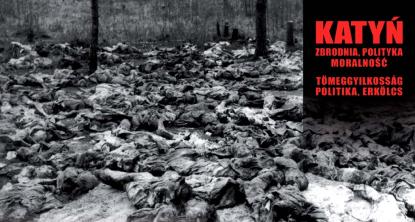2025. November 5. Wednesday
Black House - Szeged
|
|
Address: 6720, Szeged Somogyi utca 13.
Phone number: (62) 425-033
E-mail: info@mfm.u-szeged.hu
Opening hours: Mon-Wed 10-18, Thu 10-20, Fri-Sun 10-18
|
The exhibition has closed for visitors.
2009.04.03. - 2009.05.18.
Museum tickets, service costs:
|
Ticket for adults
|
1290 HUF
|
|
|
Ticket for students
|
690 HUF
|
|
|
Ticket for pensioners
(under 65 years of age)
|
690 HUF
|
|
|
Ticket for families
(2 adults + 3 children)
|
2990 HUF
|
/ family
|
|
Guide
|
5000 HUF
|
The Katyn Massacre was one of the most brutal political murder series in the 20th century with over 22.000 Polish citizen victims.The Russians killed thousands of military officers, 760 doctors, 1040 teachers and over 100 lawyers.

The exhibition helps the visitors to understand the Polish tragedy that is still painful for thousands of Polish people. The organizers of the showing intend to show how this massacre could happen via photos and documents.
In 1940, Beria made his proposal to Stalin to murder 147000 Polish military officers and 11000 citizens. The document was signed by both of them on 5 May. The massacre began on 3 Aril 1940 and lasted all through May, in the prisons until the autumn of 1940.
The victims were transported by trains or vans, but often ha to walk to the location of their homicide. The young and strong military officers had their sleeved pulled over their heads and their hands were tied with Russian rope. The captives were injected with cholera and typhoid vaccine, some believe, to make them believe that they were transported west.
The executions were performed one by one, with pistols.
The massacre had some Hungarian connections, too. Emanuel Korompay, the reserve captain, reader for the Warsaw University, lost his life in Katyn. Emanuel Korompay edited the first Polish-Hungarian dictionary. After WWII broke out, Emanuel Korompay was mobilized as a reserve captain. He was taken captive at the eastern frontiers and shot into the mass graves in Harkov.
The Hungarian pathologist Ferenc Orsós was among the examiners of the mass graves. For signing the record at Katyn he was sentenced to death but was never executed.
The free world kept silent about the deed of Russian army in Katyn even though the secret agencies of the USA and England were aware of the massacre. The massacre was ordered by political and party leaders. Civilians from countries that were not officially in war with the Soviet Union were taken prisoners and kept in camps then executed. The mass execution was on the agenda in Nuremberg but the Russians blamed the Germans even there for the massacre.
The exhibition on occasion of the Polish Year in Csongrád County is open until 18 May at the Black House.

The exhibition helps the visitors to understand the Polish tragedy that is still painful for thousands of Polish people. The organizers of the showing intend to show how this massacre could happen via photos and documents.
In 1940, Beria made his proposal to Stalin to murder 147000 Polish military officers and 11000 citizens. The document was signed by both of them on 5 May. The massacre began on 3 Aril 1940 and lasted all through May, in the prisons until the autumn of 1940.
The victims were transported by trains or vans, but often ha to walk to the location of their homicide. The young and strong military officers had their sleeved pulled over their heads and their hands were tied with Russian rope. The captives were injected with cholera and typhoid vaccine, some believe, to make them believe that they were transported west.
The executions were performed one by one, with pistols.
The massacre had some Hungarian connections, too. Emanuel Korompay, the reserve captain, reader for the Warsaw University, lost his life in Katyn. Emanuel Korompay edited the first Polish-Hungarian dictionary. After WWII broke out, Emanuel Korompay was mobilized as a reserve captain. He was taken captive at the eastern frontiers and shot into the mass graves in Harkov.
The Hungarian pathologist Ferenc Orsós was among the examiners of the mass graves. For signing the record at Katyn he was sentenced to death but was never executed.
The free world kept silent about the deed of Russian army in Katyn even though the secret agencies of the USA and England were aware of the massacre. The massacre was ordered by political and party leaders. Civilians from countries that were not officially in war with the Soviet Union were taken prisoners and kept in camps then executed. The mass execution was on the agenda in Nuremberg but the Russians blamed the Germans even there for the massacre.
The exhibition on occasion of the Polish Year in Csongrád County is open until 18 May at the Black House.
